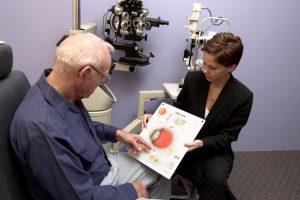 Fuchs’ dystrophy affects the cornea, over time causing decline in vision due to corneal edema and clouding. Fuchs’ dystrophy is an eye disease that occurs when the innermost layers of corneal cells begin to change. This layer of cells is responsible for the maintenance of proper fluid in the cornea. Known as the endothelium, it keeps the cornea clear in order to provide clear vision and removes excess fluid that could cause corneal swelling.
Fuchs’ dystrophy affects the cornea, over time causing decline in vision due to corneal edema and clouding. Fuchs’ dystrophy is an eye disease that occurs when the innermost layers of corneal cells begin to change. This layer of cells is responsible for the maintenance of proper fluid in the cornea. Known as the endothelium, it keeps the cornea clear in order to provide clear vision and removes excess fluid that could cause corneal swelling.
As Fuchs’ dystrophy progresses, it can lead to blisters on the cornea and swelling.
Advertisement
Unfortunately, Fuchs’ dystrophy is unpreventable, but there are treatments available to help slow down disease progression and maintain proper vision.
Fuchs’ dystrophy can affect both eyes and symptoms often occur when persons are in their 50s or 60s.
Fuchs’ dystrophy causes, risk factors, and complications
Fuchs’ dystrophy has genetic causes, as it has been found to run in families. On the other hand, there have been cases of Fuchs’ dystrophy without any family history of the condition. In many cases, the cause of Fuchs’ dystrophy is unknown.
In Fuchs’ dystrophy, the endothelium cells begin to die off and do not function properly, causing the fluid to build up and the cornea to become thicker, which contributes to the symptoms related to the eye disease.
Risk factors include being a female, having a family history of the condition, and being over the age of 50.
Complications arising from Fuchs’ dystrophy include glaucoma, expulsive hemorrhage, cataracts, graft rejection and failure, wound separation, aqueous leaks, loose sutures, infected keratitis, endophthalmitis, epithelial healing problems and ulceration, and retinal detachment.
Signs and symptoms of Fuchs’ dystrophy
 Fuchs’ dystrophy commonly affects both eyes, so the symptoms a patient may experience include:
Fuchs’ dystrophy commonly affects both eyes, so the symptoms a patient may experience include:
- Glare
- Blurred vision
- Distorted vision
- Painful, tiny blisters on the surface of the cornea
- A cloudy-looking cornea
You should see a doctor right away if you begin to experience any of these symptoms, especially if they begin to worsen. The sooner the treatment starts, the better the outcome for Fuchs’ dystrophy will be.
Fuchs’ dystrophy stages
There are three main stages of Fuchs’ dystrophy.
Stage 1 (Cornea guttata): Symptoms are mild or non-existent, pigment dusting is noticeable. Vision may be worse in the morning, but generally patients don’t experience any problems in this stage.
Stage 2: There is an increase in visual problems experienced, and patients may see halos or blurred vision and glares. There is a greater risk of infectious keratitis in stage two, and patients may experience the sensation of having a foreign body in the eye.
Stage 3: Corneal transplant may be necessary as symptoms are much worse and vision is limited.
Treatment options for Fuchs’ dystrophy
 Treatment of Fuchs’ dystrophy depends on its stage. In the early stage, vision can be improved by removing excess fluid with the assistance of eye drops. If Fuchs’ dystrophy occurs along with ocular hypertension, your doctor may also recommend glaucoma eye drops to help relieve pressure, as high eye pressure can damage the corneal endothelium.
Treatment of Fuchs’ dystrophy depends on its stage. In the early stage, vision can be improved by removing excess fluid with the assistance of eye drops. If Fuchs’ dystrophy occurs along with ocular hypertension, your doctor may also recommend glaucoma eye drops to help relieve pressure, as high eye pressure can damage the corneal endothelium.
If the disease has progressed, and there is vision deterioration and pain, a corneal transplant may be required. Normally, the surgery replaces the entire cornea, but there is an alternative surgery that only replaces the endothelium without touching the cornea. This has shown to be successful in treating Fuchs’ dystrophy with fewer risks, too.
Fuchs’ dystrophy diagnosis
There are several different diagnostic tests which your doctor may perform. For starters, staging allows your doctor to determine what stage your Fuchs’ dystrophy is at. To determine this, they will use an optical microscope and study the cells in the lining of the back of the eye. Irregular bumps indicate Fuchs’ dystrophy.
Advertisement
Your doctor will also perform a corneal pressure test by numbing the eye and measuring pressure with a device, use an instrument to measure corneal thickness, and perform a corneal cell count, which is also conducted using a special instrument.
Fuchs’ dystrophy precautions
As mentioned, there are no known prevention tips for Fuchs’ dystrophy, but there are some precautions to keep in mind.
- Always clean your eyes with sterile products
- Avoid applying makeup to the margin of the eye
- Avoid smoky and dusty environments
- Only use prescribed eye drops
- Never touch the eye directly with the eye drop nozzle
Also speak to your doctor if you were planning on undergoing laser eye surgery or if you have to undergo cataract surgery. These types of eye procedures can worsen Fuchs’ dystrophy, so you may not be able to undergo such surgeries.
